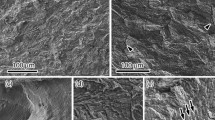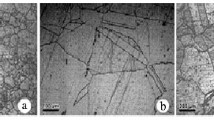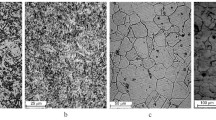Abstract
Owing to energy conservation and environmental concerns, hydrogen has been suggested as a next-generation energy source. However, hydrogen known to seep into a metal, degrade its strength, and accelerate fatigue crack growth rates. We have investigated the effects of hydrogen gas on the small fatigue crack growth characteristics of low carbon steel JIS S10C by conducting bending fatigue tests on a specimen with a small blind hole and placed in a low-pressure hydrogen environment. The fatigue crack growth rate in hydrogen was higher than that in nitrogen. The fracture surface of the specimen in hydrogen showed intergranular facets in the low- growth-rate range and a quasi-cleavage fracture surface with brittle striations in the high-growth-rate range. The specimen only showed a ductile fracture surface for nitrogen. The small-fatigue-crack growth rate for nitrogen is given by \({dl/dN\propto \Delta \varepsilon_{p}^{n}l}\), where l, N, and \({\Delta \varepsilon_{p}}\) represent the crack length, number of repetitions, and plastic strain range, respectively. This equation was also satisfied for hydrogen, but only over a short strain range from \({\Delta \varepsilon_t = 0.25}\) to 0.37 % in which the fracture surface exhibited intergranular facets and a ductile morphology, but no quasi-cleavage fracture. The exponent n of the equation was 1.22 in nitrogen and 0.66 in hydrogen environment. The small-fatigue-crack growth law can be used for safe material designs in hydrogen environments.
Similar content being viewed by others
References
Bernstin IM, Thompson AW (1980) Hydrogen effects in metals. Proceedings of the 3rd international conference on effect of hydrogen on behavior of materials, Metall Soc AIME, USA, Wyoming, August 26–31
Birnbaum HK, Sofronis P (1994) Hydrogen-enhanced localized plasticity—a mechanism for hydrogen-related fracture. Mater Sci Eng A 176: 192–202
Booklet (2001) Special issue on recent advances in the engineering aspects of hydrogen embrittlement. Eng Fract Mech 68-6
Cotterill PJ, King JE (1993) The influence of a coal gasifier atmosphere on fatigue crack growth rates in BS 4360 steel. Int J Fatigue 15(1): 27–30
El Haddad MH, Dowling NE, Topper TH, Smith KN (1980) J integral applications for short fatigue cracks at notches. Int J Fract 16: 15–30
Fukuyama S, Yokogawa K, Kudo K (1983) Fatigue properties of SUS 304 stainless steel in high pressure hydrogen at room temperature. J Soc Mater Sci JAPAN 32–355: 82–86 (in Japanese)
Fukuyama S, Han GK, He GH, Yokogawa K (1997) Effect of high pressure hydrogen gas on crack growth of carbon steel. J Soc Mater Sci JAPAN 46–6: 607–612 (in Japanese)
Goto M (1991) Statistical investigation of the behaviour of microcracks in carbon steels. Fatigue Eng Mater 14: 833–845
Hagihara A, Oda Y, Noguchi H (2007) Influence of testing frequency on fatigue crack growth of 6061-T6 aluminum alloy in hydrogen gas environment. Key Eng Mater 353-358: 174–177
Hirth JP (1980) Effects of hydrogen on the properties of iron and steel. Metall Trans A 11: 861–890
Hudak SJ Jr. (1981) Small crack behavior and the prediction of fatigue life. ASME 103: 26–35
Kawamoto K, Oda Y, Noguchi H, Higashida K (2007) Effects of hdrogen gas environment on fatigue crack growth of a stable austenitic stainless steel. J Solid Mech Mater Eng 263–274
Kitagawa H, Takahashi S, Suh CM, Miyashita S (1979) Quantitative analysis of fatigue process-microcracks and slip lines under cyclic strains. ASTM STP 675: 420–449
Kuo AS, Liu HW (1976) An analysis of unzipping model for fatigue crack growth. Scripta Met 10–8: 723–728
Miller KJ (1982) The short crack problem. Fatigue Eng Mater Struct 5: 223–232
Murakam Y, Harada S, Endo T, Tani-ishi H and Fukushima Y (1983) Correlations among growth law of small cracks, low-cycle fatigue law and applicability of miner’s rule. Eng Fract Mech 18–5: 909–924 (in Japanese)
Murakami Y, Makabe C, Nisitani H (1984) Relationship between the low-cycle fatigue law and the growth law of small cracks in 70–30 Brass. Trans Jpn Soc Mech Eng A 50–459: 1828–1837 (in Japanese)
Nisitani H (1981) Unifying treatment of fatigue crack growth laws in small, large and non-propagating cracks. Mech Fatigue AMD 47: 151–166
Nisitani H, Goto M (1987) A small crack growth law and its application to the evaluation of fatigue life. In: Miller KJ, de los Rios, ER (ed) Behavior of short fatigue cracks, Mech Eng Publishers pp 461–478
Nisitani H, Goto M, Kawagoisi N (1984) Effect of stress ratio on the propagation of small crack of plain specimens under high and low stress amplitudes: fatigue under axial loading of annealed 0.45 % C steel. Trans Jpn Soc Mech Eng A 50–453: 1090–1096 (in Japanese)
Nisitani H, Morimitsu T (1976) Estimation of crack propagating property by the rotating bending fatigue tests of specimens with a small hole. Bull Jpn Soc Mech Eng 19–136: 1091–1099
Neumann P (1969) Coarse slip model of fatigue. Acta Metall 17(9): 1219–1225
Neumann P (1974) New experiments concerning the slip processes at propagating fatigue cracks—I. Acta Metall 22-9: 1155–1165
Oda Y, Noguchi H (2005) Observation of hydrogen effects on fatigue crack growth behaviour in an 18Cr-8Ni austenitic stainless steel. Int J Fract 132: 99–113
Ritchie RO, Lankford J (1996) Small fatigue cracks: a statement of the problem and potential solution. Meter Sci Eng 84: 11–16
Suresh S, Ritchie RO (1984) Propagation of short fatigue cracks. Int Met Rev 29: 445–476
Troiano AR (1960) The role of hydrogen and other interstitials in the mechanical behavior of metals. Trans Am Soc Met 52: 54–80
Yoshioka S, Demizu M, Kumasawa M, Hijikata A (1980) Effect of hydrogen gas environment on fatigue crack growth in Ni-Mo-V steels. J Soc Mater Sci JAPAN 29(321): 628–633 (in Japanese)
Yoshioka S, Demizu M, Kumasawa M (1983) Fatigue crack growth behavior in hydrogen gas environment. J Soc Mater Sci JAPAN 32–355: 435–440 (in Japanese)
Author information
Authors and Affiliations
Corresponding author
Rights and permissions
About this article
Cite this article
Lee, D., Nishikawa, H., Oda, Y. et al. Small fatigue crack growth characteristics and fracture surface morphology of low carbon steel in hydrogen gas. Int J Fract 179, 147–156 (2013). https://doi.org/10.1007/s10704-012-9783-2
Received:
Accepted:
Published:
Issue Date:
DOI: https://doi.org/10.1007/s10704-012-9783-2




